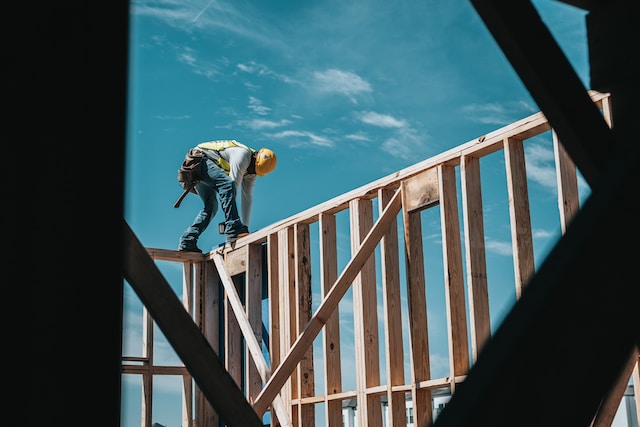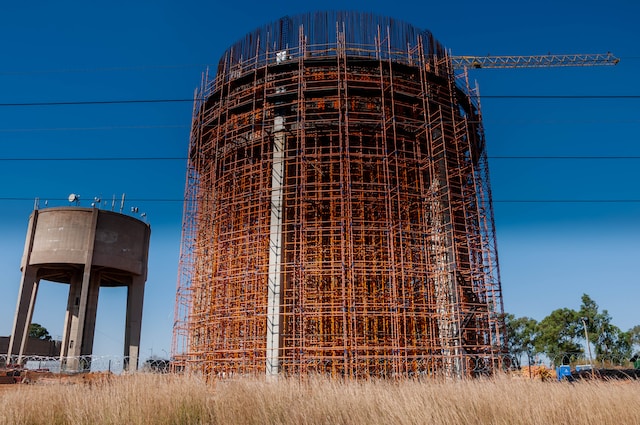The Role of Scaffolding in Skyscraper Construction

Have you ever wondered how people manage to build skyscrapers without falling off when you’re strolling past a construction site? Actually, scaffolding keeps them safe, not magic or luck.
Or maybe you are a new hire on a construction site and still wondering about the main role of scaffoldings and how they work. If so, this article is perfect for you as it explains the importance of scaffolding for worker safety and accident prevention on skyscraper construction sites and its different types.
The Challenge of Skyscraper Construction
Skyscrapers, like the Burj Khalifa or the Empire State Building, are engineering marvels that push the boundaries of height and design. But constructing them comes with its own set of unique challenges. As these buildings soar into the sky, traditional construction methods alone simply won’t cut it. This is where different kinds of scaffolding come into play.
The Foundation of Safety
In skyscraper construction, safety is the top priority. Building at such extreme heights requires a robust support system to prevent accidents. Scaffolding serves as this vital safety net, providing a secure base for the construction puzzle as it all comes together. Aside from taking workers to higher parts of the construction sites, this is one of the main roles of scaffolding.
Creating a Stable Platform
Scaffolding in skyscraper construction is a secure platform that keeps workers safe while carrying out tasks. These platforms are carefully designed to handle heavy loads and provide a stable surface. Picture it as a giant, real-life LEGO set, interlocking piece by piece to create a solid foundation for the structure to grow.
Reaching New Heights
Skyscrapers are known for their dizzying heights; scaffolding makes those heights accessible. Workers can’t fly up to the 100th floor but can safely climb there using scaffolding. It acts as a construction elevator that lets workers soar higher and higher, allowing workers to reach every nook and cranny of the skyscraper’s facade.
Efficient Workflow
Scaffolding isn’t just about safety and accessibility; it’s about efficiency. When you’re building a skyscraper, time is money. Scaffolding streamlines the workflow, ensuring that workers and materials are where they need to be when they need to be there. It’s like a well-organized assembly line in the sky, making sure everything runs smoothly and on schedule.
Custom Solutions
Each skyscraper is unique, and scaffolding solutions are tailored to suit the building’s design and construction requirements. This adaptability is like a custom-made suit for each skyscraper, ensuring a perfect fit and functionality. Whether it’s a sleek glass tower or a curvaceous masterpiece, scaffolding molds itself to the project’s needs.
Supporting Every Phase
The construction of a skyscraper happens in phases, from laying the foundation to installing the glass windows at the pinnacle. Scaffolding doesn’t just stick around on the lower floors. It moves up, following the building’s ascent. It’s like a reliable partner from start to finish, adapting and climbing with the skyscraper.
Different Types of Scaffolding Systems

Scaffolding is not a one-size-fits-all solution in construction sites. Different types of scaffolding systems are designed to suit specific needs and circumstances. Learn these systems in more detail to understand when and where they are most commonly used:
Supported Scaffolding
It’s the most common type you’ll encounter on construction sites and is used for a wide range of tasks. This system relies on sturdy vertical and horizontal support elements, typically constructed from materials like steel or aluminum, which provide a stable platform for construction workers. Supported scaffolding is versatile and can be adapted for both simple and complex projects.
Suspended Scaffolding
Sometimes, construction tasks require workers to access areas above the ground, such as high-rise buildings or bridges. Suspended scaffolding is the ideal solution for these situations. Ropes, cables, or chains support the platform, making it similar to a construction worker’s swing set. This system allows workers to reach tricky spots without the need for extensive ground-based support.
Mobile Scaffolding
Mobile scaffolding is all about convenience and mobility. Picture a tall structure mounted on wheels, and you’ve got mobile scaffolding. This system is perfect for projects that require workers to move quickly or cover large areas. The wheels provide flexibility, allowing workers to access different parts of the construction site with ease.
Cantilever Scaffolding
In certain situations, it’s not possible to build scaffolding from the ground up, such as when a structure is hanging over a river, street, or any obstacle. Cantilever scaffolding comes to the rescue. This scaffolding extends horizontally from a structure, offering a secure platform for construction work. This method ensures work can be performed safely and efficiently, even in challenging conditions.
Aerial Lifts
Imagine needing to work on the side of a skyscraper or a tall structure. Climbing or manually building scaffolding may not always be the safest or most practical option. Aerial lifts, such as cherry pickers and boom lifts, provide workers with a reliable and secure way to access great heights. These lifts are designed to reach high places safely, offering stability and security even in challenging environments.
Trestle Scaffolding
For smaller tasks like painting a ceiling or fixing a wall, trestle scaffolding is the way to go. This type of scaffolding is like setting up a mini construction stage. It provides just enough elevation and space for your tools and materials, making it perfect for small-scale DIY projects too. Trestle scaffolding is portable and easy to assemble, and it ensures that even minor tasks can be completed efficiently and safely.
Scaffolding, the Future of Skyscrapers
Once a skyscraper is part of a city’s skyline, it still needs scaffolding like replacing windows, fixing the outside, and even making the building more energy-efficient. This constant need for scaffolding shows how important it is to keep these building giants alive and well for a long time.
So as you enjoy the grandeur of skyscrapers, keep in mind that scaffolding is still an important part of keeping them looking good and making them work better long after they’re gone. If you require quality scaffoldings, visit All Trade Scaffolding and find the right one for your project.
More Resources:


























